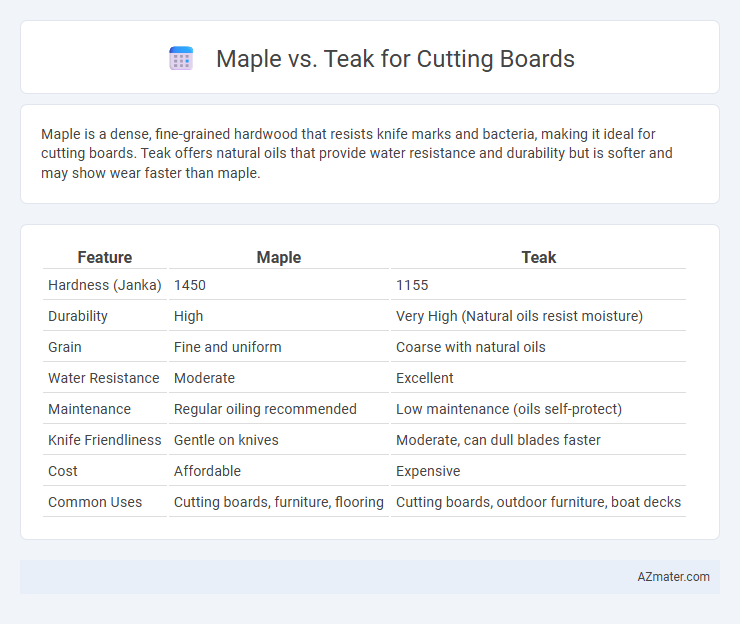Maple is a dense, fine-grained hardwood that resists knife marks and bacteria, making it ideal for cutting boards. Teak offers natural oils that provide water resistance and durability but is softer and may show wear faster than maple.
Table of Comparison
| Feature | Maple | Teak |
|---|---|---|
| Hardness (Janka) | 1450 | 1155 |
| Durability | High | Very High (Natural oils resist moisture) |
| Grain | Fine and uniform | Coarse with natural oils |
| Water Resistance | Moderate | Excellent |
| Maintenance | Regular oiling recommended | Low maintenance (oils self-protect) |
| Knife Friendliness | Gentle on knives | Moderate, can dull blades faster |
| Cost | Affordable | Expensive |
| Common Uses | Cutting boards, furniture, flooring | Cutting boards, outdoor furniture, boat decks |
Introduction: Maple vs Teak Cutting Boards
Maple cutting boards are renowned for their fine grain and durability, making them resistant to knife marks and ideal for heavy use. Teak cutting boards boast natural oil content that provides excellent water resistance and antimicrobial properties, enhancing hygiene in food preparation. Choosing between maple and teak depends on preferences for maintenance, aesthetics, and specific kitchen needs.
Wood Characteristics: Maple and Teak Compared
Maple features a tight, fine grain with high hardness, making it resistant to knife marks and ideal for cutting boards that endure heavy use. Teak's natural oils provide exceptional moisture resistance and antibacterial properties, reducing the risk of warping and bacterial growth over time. While maple requires regular oiling to maintain durability, teak's inherent oils offer low maintenance and longevity in humid kitchen environments.
Durability and Longevity
Maple cutting boards are highly durable and resistant to knife marks due to their tight grain structure, making them ideal for long-term use. Teak offers exceptional longevity because of its natural oils, which provide water resistance and reduce the risk of warping or cracking. While maple requires regular maintenance to prevent drying, teak's oily composition demands less upkeep, contributing to its lasting durability in kitchen environments.
Knife Friendliness and Surface Hardness
Maple is renowned for its excellent knife friendliness due to its moderate surface hardness, typically around 1450 on the Janka scale, which provides a good balance between durability and gentleness on knife edges. Teak exhibits higher surface hardness, approximately 1155 to 1180 on the Janka scale, making it slightly harder and more resistant to wear but potentially more abrasive to knives over time. Choosing maple for cutting boards preserves blade sharpness longer, while teak offers greater resistance to moisture and warping but may require more frequent sharpening of knives.
Water Resistance and Maintenance
Maple cutting boards offer moderate water resistance due to their tight grain, requiring regular oiling to maintain durability and prevent warping. Teak possesses natural oils that enhance water resistance, reducing the frequency of maintenance and minimizing the risk of bacterial growth. Both woods benefit from proper drying and conditioning, but teak's inherent moisture resistance makes it superior for wet environments.
Food Safety and Bacterial Resistance
Maple cutting boards are renowned for their tight grain structure, which resists moisture absorption and minimizes bacterial infiltration, making them highly food-safe. Teak contains natural oils with antimicrobial properties that help inhibit bacterial growth, but its looser grain can retain more moisture, potentially harboring bacteria if not properly maintained. Both woods offer robust food safety features, but maple's dense, closed grain typically provides superior bacterial resistance for cutting board use.
Aesthetic Appeal and Color Differences
Maple cutting boards feature a light, creamy color with subtle, consistent grain patterns, offering a clean and classic aesthetic that brightens kitchen spaces. Teak boards boast rich, golden-brown tones with natural oil-infused grains, presenting a warm, luxurious look that deepens with age. The color stability of maple remains relatively uniform over time, while teak's hues can darken and develop a unique patina, enhancing its visual character.
Cost and Value for Money
Maple cutting boards typically cost less than teak, offering excellent durability and resistance to knife marks at a more affordable price point. Teak boards, while more expensive due to their natural oils and resistance to moisture, provide longer-lasting value by reducing the need for frequent replacements. Choosing maple delivers better initial cost savings, whereas teak offers superior long-term value for money through extended lifespan and maintenance ease.
Environmental Impact and Sustainability
Maple cutting boards are often considered more sustainable due to the abundance of sugar maple trees and their faster growth rates compared to teak. Teak, sourced primarily from tropical rainforests, raises environmental concerns due to deforestation and longer maturation periods. Choosing FSC-certified maple ensures responsible forest management and a lower carbon footprint for eco-conscious consumers.
Which Wood is Best for Your Cutting Board?
Maple is widely regarded as the best wood for cutting boards due to its fine grain, durability, and resistance to knife marks, making it highly hygienic and easy to maintain. Teak offers exceptional water resistance and natural oils that reduce bacterial growth, but its coarser grain may cause more wear on knife edges over time. Choosing between maple and teak depends on whether you prioritize a smooth cutting surface and longevity (maple) or enhanced moisture resistance and natural antimicrobial properties (teak).

Infographic: Maple vs Teak for Cutting Board
 azmater.com
azmater.com